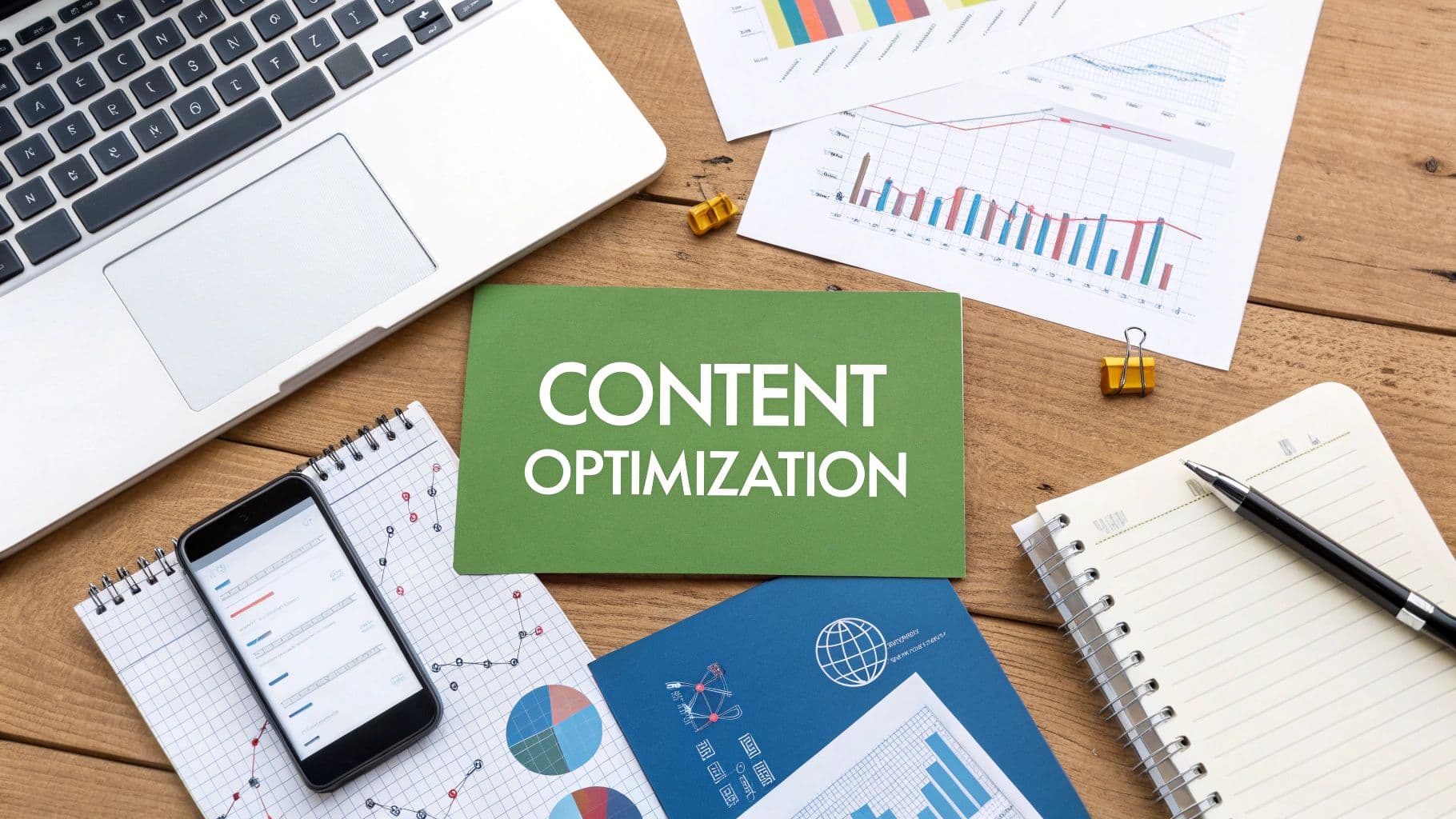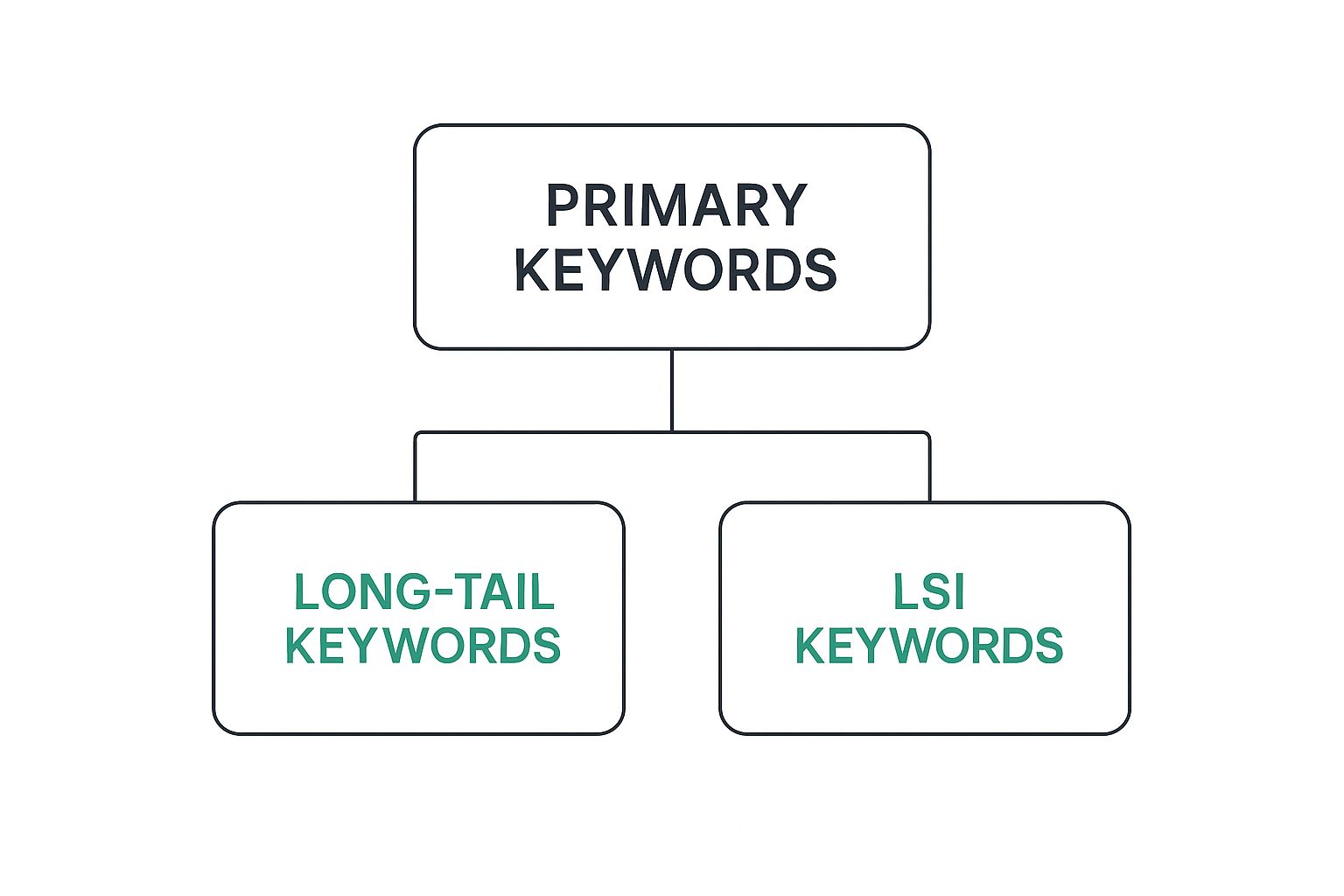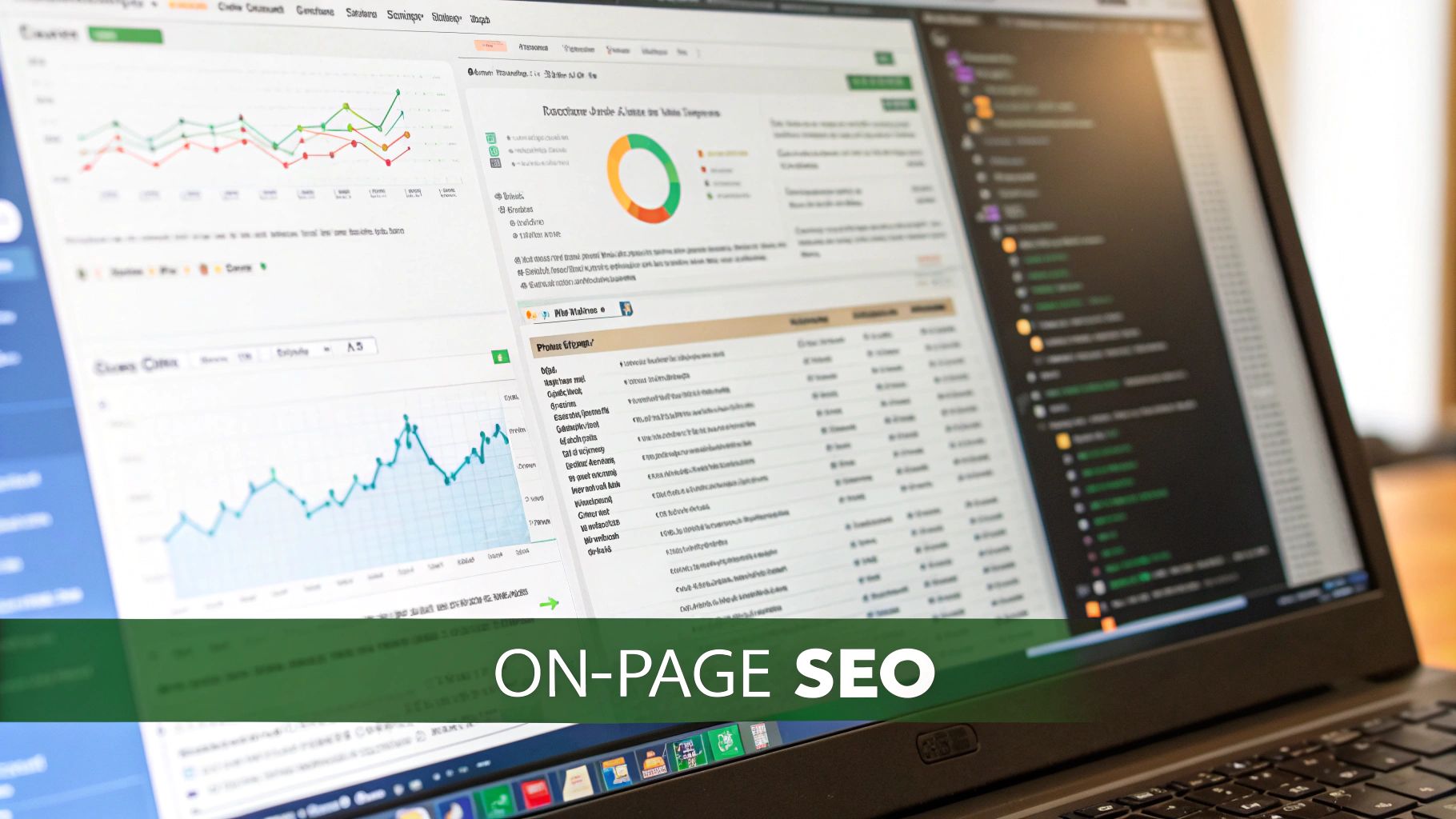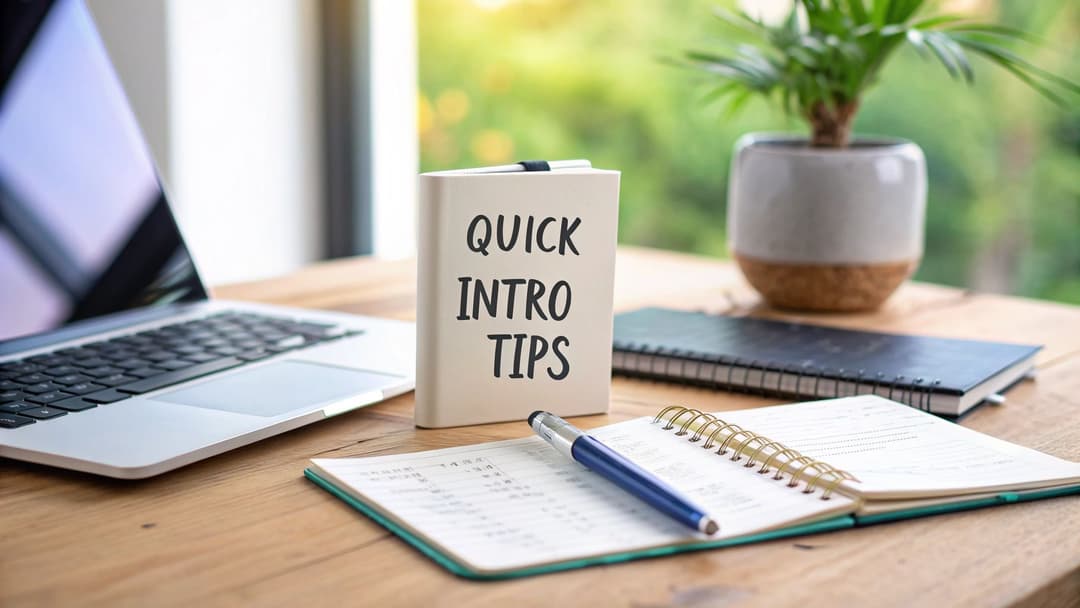
What Is Content Optimization and How Does It Work?
October 7, 2025
Ever publish something you were proud of, only to have it disappear into the digital void? It's like writing a brilliant book and shelving it in a library with millions of others, with no card catalog to guide readers to it.
Content optimization is the art of making sure your work gets found and actually read by the right people. It’s a mix of science and craft—refining your content so it not only climbs the search engine rankings but also genuinely connects with your audience.
Understanding Content Optimization at a Glance

At its heart, content optimization isn't a simple checklist you can tick off. It's a strategic mindset. Think of it as building a bridge between what your audience is desperately searching for and the solutions you offer.
This goes way beyond just stuffing a few keywords into a blog post. It's a holistic effort to polish every single aspect of your content for two very different, but equally important, audiences: search engine algorithms and the human beings on the other side of the screen.
The Two Sides of Optimization
You're essentially on a dual mission. On one hand, you need to speak the language of search engine bots. This means giving them the right signals—keywords, clear meta descriptions, structured data—so they can easily understand what your page is about and why it deserves a top spot.
On the other hand, you need to create an experience for your human readers that is engaging, valuable, and effortless. A perfectly optimized piece of content nails both without compromise. It’s where technical SEO meets great storytelling.
Here’s a quick look at the main goals when optimizing for both sides.
Key Goals of Content Optimization
| Goal | For Search Engines | For Human Readers |
|---|---|---|
| Visibility | Index and rank for relevant search queries. | Easily find answers to their questions. |
| Clarity | Understand the topic and context of the page. | Quickly grasp the main points without confusion. |
| Relevance | Match content to specific search intent. | Feel that the content directly addresses their needs. |
| Engagement | See signals like low bounce rates and high time on page. | Stay interested, read through, and take action. |
Ultimately, a well-executed strategy brings these two worlds together, creating content that performs well because it serves the reader first.
Content optimization isn’t just about getting found on Google; it’s about being the best possible answer when you are found. It turns passive readers into active followers and customers.
Getting this right is a huge piece of the content marketing puzzle. The industry itself was valued at a massive $413.2 billion in 2022 and is expected to hit nearly $2 trillion by 2032.
That kind of growth tells you one thing: the demand for high-quality, strategically optimized content that can actually cut through the noise isn't going anywhere. For more on this, you can explore the latest content marketing trends that underscore just how valuable this approach is.
Here is the rewritten section, following the specified human-like style and formatting.
Why Your Content Needs Optimization to Survive
Putting together a great piece of content is a huge win, but it’s really just the starting line. Without a smart optimization plan, even the best article is like a billboard in the middle of the desert—brilliant, but no one will ever see it. It just becomes another ghost in the digital machine, totally invisible to search engines and lost in the noise.
Honestly, publishing content without optimizing it is one of the fastest ways to watch a marketing campaign fail. You pour time, money, and creativity into something, only for it to get a handful of views and zero leads. This isn't just a missed opportunity; it’s a waste of resources that chips away at your bottom line.
Drive Sustainable Organic Traffic
The first and most obvious win from content optimization is climbing up the search engine rankings. When you tune your content to the exact phrases and questions your audience is typing into Google, you’re basically handing them a map to your front door.
This isn’t about a temporary spike in traffic. It’s about building a long-term, reliable engine that brings in visitors organically. Unlike paid ads that die the second you stop paying, a well-optimized article can keep attracting the right people for months, sometimes even years. It’s the gift that keeps on giving.
Think of it this way: Content optimization closes the gap between what you create and who finds it. It makes sure the value you worked so hard to build actually reaches the people who need it.
Boost Engagement and Build an Audience
Optimization is so much more than just keywords. A huge piece of the puzzle is improving the actual experience for the reader. Is your content easy to read? Does it look good on the page? Is it genuinely helpful? When someone lands on your page and gets exactly what they were looking for, they stick around.
That sends all the right signals, both to search engines and to your future customers.
- Lower Bounce Rates: People don't click away immediately because the content actually answers their question.
- Higher Time on Page: They spend more time reading, which tells Google your content is valuable.
- Real Loyalty: A good experience builds trust, and trust brings people back again and again.
These metrics do more than just make your analytics look good. They tell search algorithms that you're a quality source, which helps you rank even higher. More importantly, it’s how you turn a one-time visitor into a loyal fan.
Achieve Higher Conversion Rates
At the end of the day, your content has a job to do. Whether that’s generating leads, selling a product, or just getting an email signup, optimization is what gets it done. When you truly understand what your reader is looking for—their intent—you can create content that not only gives them an answer but also guides them to the next logical step.
An optimized article doesn't just pull in random traffic; it attracts the right traffic. The people who show up are already primed to be interested in what you offer. By hitting their pain points head-on and showing them a clear path forward, your content stops being a simple blog post and becomes a powerful conversion tool that turns readers into customers.
The Three Pillars of Modern Content Optimization
Great content optimization isn't about ticking a few boxes. It's more like a three-legged stool—if one leg is shaky, the whole thing topples over. To build something sturdy, your strategy needs to stand firmly on three pillars that work together.
These pillars make sure your content is easy to find, enjoyable to read, and genuinely trustworthy. When you get all three right, you create a holistic strategy that works for both search engine algorithms and, more importantly, the real people reading your stuff.
Pillar One: Search Intent and SEO
This is the foundation. It’s where you line up what you're writing with what people are actually searching for. This goes way beyond just stuffing a keyword into a page; it’s about decoding the search intent behind the query. Is someone looking for information? A specific product? A comparison of their options?
Getting this right sets the entire direction for your content. From there, you can start weaving in your main keyword and all the related secondary phrases that make sense. SEO is still the name of the game here. In fact, a combination of websites, blogs, and SEO accounted for 16% of all channels that delivered the highest ROI in digital marketing. A whopping 91% of marketers also reported that SEO directly improved their website's performance.
To really nail this pillar, you've got to learn how to conduct keyword research the right way. It’s how you uncover the exact language your audience is using, which is the first step to creating something that actually connects.

As you can see, a broad keyword is just the starting point. It branches out into more specific, long-tail phrases that help you grab the attention of a much more targeted audience.
Pillar Two: Readability and User Experience
So, you’ve earned the click. Now what? The second pillar kicks in the moment someone lands on your page. It doesn't matter how well you rank if your content is just a massive, unreadable wall of text. Readability and user experience (UX) are all about making your information easy—and even pleasant—to get through.
This pillar is all about the practical stuff:
- Short Paragraphs: Break up your text into small, 1-3 sentence chunks. It makes everything scannable.
- Clear Headings: Use H2s and H3s to guide readers through the page so they can find what they need.
- Compelling Visuals: Images, videos, and charts break up the monotony and can explain a complex idea in seconds.
- White Space: Don't crowd the page. Giving your words room to breathe makes the whole experience less overwhelming.
Modern optimization also means paying attention to the technical details. A slow-loading page, for instance, is a surefire way to frustrate visitors and send them packing. Learning how to optimize website performance is a non-negotiable part of creating a great user experience.
Pillar Three: Authority and Trustworthiness
This final pillar is what separates decent content from truly great content. We're all swimming in a sea of information, and both people and search engines are getting better at spotting sources they can actually trust. This is exactly what Google’s E-E-A-T (Experience, Expertise, Authoritativeness, and Trustworthiness) guidelines are all about.
You build authority by consistently providing accurate, well-researched, and helpful information. Over time, this transforms your content from a simple answer into a trusted resource.
To make this pillar strong, get in the habit of citing credible sources, keeping your information fresh and up-to-date, and showing—not just telling—that you know your stuff. When you prove you're a reliable resource, you'll be rewarded by search engines and your audience alike.
Building Your Content Optimization Toolkit
Guesswork isn't a strategy for successful content optimization. If you want to consistently create pieces that rank and resonate with readers, you need a solid set of tools to guide your decisions. Think of it like building a workshop—each tool has a specific job, from the initial blueprint to the final performance review.
You don't need a dozen expensive subscriptions to make a real impact. Instead, focusing on a few key categories will give you the power to make data-driven improvements at every single stage of the content process. These tools turn good articles into great ones.
Keyword Research and Strategy Platforms
It all starts with knowing what your audience is searching for. Keyword research platforms are your compass, helping you uncover the exact terms and phrases people type into Google when they have a problem. These tools reveal crucial data like search volume, keyword difficulty, and, most importantly, user intent.
Tools like Ahrefs or SEMrush are the industry gold standard for a reason. They let you peek over your competitor's shoulder to see what they're ranking for, find gaps in their strategy you can exploit, and discover high-impact, low-competition keywords for your own content.
Just look at this screenshot from Ahrefs' Keyword Explorer, which gives a detailed analysis for a single search term.

This dashboard gives you an instant snapshot of a keyword's potential. You can immediately see how hard it might be to rank and its potential traffic value, which is vital information for prioritizing where you spend your time.
On-Page Analysis and Writing Assistants
Once you have your target keywords, the next job is to weave them into your content naturally. On-page analysis tools act as a real-time coach, scoring your draft against the top-ranking pages and giving you actionable suggestions for improvement.
- Content Graders: Tools like SurferSEO or Clearscope analyze your text and recommend related terms to include, ideal word counts, and even structural improvements based on what's already winning in the search results.
- Readability Editors: Platforms such as Grammarly and the Hemingway Editor are all about polishing your writing. They catch grammatical mistakes and suggest ways to make your sentences clearer and more concise—a must-have for keeping readers engaged.
These assistants are essential for making sure your content is both SEO-friendly and reader-friendly. You can learn more about how to nail this balance in our complete guide on how to optimize content for SEO.
Performance Tracking and Analytics
At the end of the day, you can't improve what you don't measure. Performance tracking tools show you how your content is actually doing once it's out in the wild. They’re your report card, revealing what’s working and what needs a refresh.
The most crucial tool in this category is Google Analytics. It provides invaluable data on organic traffic, page views, bounce rates, and user behavior, helping you understand how visitors interact with your content.
By regularly checking these metrics alongside tools like Google Search Console, which tracks your keyword performance, you can identify underperforming content and spot new opportunities for optimization. This feedback loop is the engine that drives a successful long-term content strategy.
How AI Is Reshaping Content Optimization

Artificial intelligence has officially graduated from a buzzword to a powerful co-pilot for anyone serious about content optimization. It’s not here to replace human creativity. Instead, AI tools are more like incredibly fast, insightful assistants that can analyze mountains of data to give you a sharp competitive edge.
Think of AI as a tireless researcher on your team. It can sift through thousands of top-ranking articles in seconds to find content gaps, map out strategic topic clusters, and help you nail user intent with a precision that used to be impossible. This data-first approach takes a lot of the guesswork out of the optimization game.
Accelerating the Creative Workflow
Generative AI platforms like ChatGPT are especially good at greasing the wheels in the early stages of content creation. You can use them to brainstorm compelling angles, build a logical outline, or even tighten up your copy for better clarity. This frees up your team to focus on high-level strategy instead of getting bogged down in the manual, tedious parts of the job.
And this shift is happening fast. Roughly 90% of content marketers are already planning to bring AI into their workflow. It's clearly paying off, too—marketers using AI are far less likely to say their strategies are underperforming. You can dig deeper into how AI is making waves by checking out the latest content marketing statistics.
Of course, this speed comes with a new challenge. With so much AI-assisted content flooding the internet, authenticity and a natural human voice matter more than ever. Running your text through an AI writing checker can be a good quality control step to flag anything that sounds robotic or out of place.
A Partnership Between Human and Machine
It’s a mistake to see AI as a replacement for human marketers. It’s an amplifier. AI is brilliant at processing data and spotting patterns, but it has zero genuine experience, empathy, or strategic gut instinct. The magic happens when you pair the two.
AI provides the data-driven insights, while human writers provide the creativity, storytelling, and strategic direction. This combination enables teams to produce more impactful content at a faster pace than ever before.
This collaborative approach is how you scale your content optimization without losing your soul. By letting AI handle the heavy lifting on the data side, you free up your creators to do what they do best: connect with an audience on a real, human level.
Measuring the Success of Your Optimized Content
Publishing a freshly optimized article and then just walking away is like sending a message in a bottle. You hope it reaches someone, but you have no real idea if it ever does. If you want to know what content optimization really is in practice, you have to measure its impact. Otherwise, you’re just guessing.
Tracking your content’s success shows you what’s working, what’s falling flat, and where to put your energy next. It’s the feedback loop that turns a good piece of content into a genuine, high-performing asset. To really see if your hard work is paying off, measuring content performance is non-negotiable. It’s how you prove the value of what you’re doing.
Key Visibility Metrics
Visibility metrics answer one simple question: are people finding your content? If these numbers aren't going up, nothing else matters. They're the first—and most important—signs that your optimization efforts are actually working.
- Keyword Rankings: This is all about where your content shows up in search results for your target keywords. A jump from page two to page one isn't just a small step; it's a huge win.
- Organic Traffic: The number of people who land on your page directly from a search engine. This is the ultimate proof that your SEO strategy is pulling in an audience.
- Impressions: This is how many times your content appeared in search results. A ton of impressions but a low click-through rate can be a red flag, often signaling that your title or meta description needs a rewrite.
Essential Engagement Metrics
So, you got them to click. Now what? Engagement metrics tell you if the content is actually connecting with the audience you worked so hard to attract. High engagement sends all the right signals to search engines, basically telling them, "Hey, this page is valuable."
Strong engagement is the difference between a visitor who clicks away instantly and one who becomes a loyal reader. It validates that your content truly delivers on its promise.
Keep an eye on these key performance indicators:
- Time on Page: Simply put, how long are people sticking around to read what you wrote? More time on the page usually means they're finding it useful and interesting.
- Bounce Rate: The percentage of visitors who leave your site after viewing only one page. A high bounce rate could mean your content didn't quite match what they were looking for.
- Scroll Depth: How far down the page are people actually scrolling? This is a great way to see if your intro hooked them and if the rest of the content is compelling enough to keep them reading.
Now, let's pull all these ideas together. Tracking these metrics isn't just about collecting data; it's about understanding the story that data tells about your audience and your content.
Key Metrics for Measuring Content Performance
This table breaks down the crucial KPIs you should be tracking, what they actually indicate, and the tools you can use to find them.
| Metric Category | Key Metric | What It Measures | Tool to Use |
|---|---|---|---|
| Visibility | Keyword Rankings | Your position in SERPs for target keywords. | Ahrefs, Semrush |
| Visibility | Organic Traffic | The number of visitors from organic search. | Google Analytics, Google Search Console |
| Visibility | Impressions | How often your page appears in search results. | Google Search Console |
| Engagement | Time on Page | The average duration a user spends on your page. | Google Analytics |
| Engagement | Bounce Rate | The percentage of single-page sessions. | Google Analytics |
| Engagement | Scroll Depth | How far down the page users scroll. | Hotjar, Clarity |
By consistently monitoring these metrics, you can move from "I think this is working" to "I know this is working, and here's why." It's this data-driven approach that separates amateur content creators from seasoned professionals.
Still Have Questions About Content Optimization?
Even with a solid plan, a few questions always seem to pop up. Let's clear up some of the common ones so you can spend your time on what really moves the needle.
How Often Should I Optimize Existing Content?
This is a great question. As a general rule, you should plan to audit and refresh your most important content every 6-12 months.
That gives you enough time to spot outdated stats, add new insights, and maybe even target some new secondary keywords that have cropped up. For your A-list pages—the ones bringing in the most traffic—I'd even suggest a quarterly review. It's the best way to stay ahead of algorithm tweaks and whatever your competitors are doing.
What's the Difference Between SEO and Content Optimization?
I love this question because the two are so closely related. Think of it this way: SEO is the entire blueprint for building a house. It covers the foundation, the wiring, the plumbing—all the technical stuff that makes the house visible and easy for search engines to crawl.
Content optimization, on the other hand, is how you furnish and decorate each individual room. It’s about making every single piece of content perfect for the people you want to attract. It's a crucial part of the bigger SEO picture, focusing squarely on the quality and relevance of the words, images, and videos on the page.
Can I Optimize Content for Social Media Too?
Absolutely. Optimization isn't just for Google. It's about adapting your content to perform its best on any platform, and social media is a perfect example.
For a platform like Instagram or LinkedIn, optimization looks a little different. It means things like:
- Writing copy that fits the character limits and matches the platform's vibe.
- Using the right hashtags to help new people discover your post.
- Picking visuals that will stop someone from scrolling, like a great video or a carousel.
- Crafting captions that actually start a conversation.
The goal is always the same, no matter the platform: get in front of the right audience and make a connection.
Ready to transform your AI drafts into polished, human-like content that connects with readers? Natural Write instantly refines robotic text, ensuring your message is clear, engaging, and bypasses AI detection. Try our free tool today at https://naturalwrite.com.


